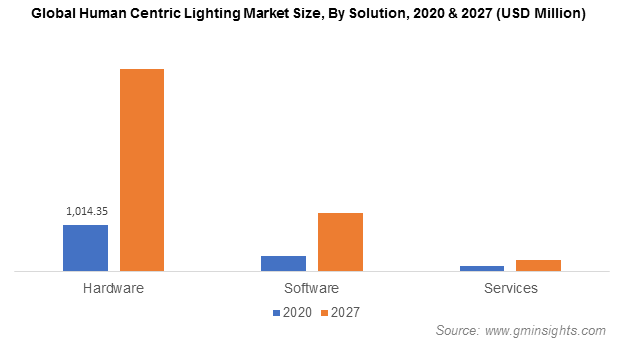Human Centric Lighting Market size worth over $5.5 Bn by 2027
Published Date: March 2021
Human Centric Lighting Market size is set to exceed USD 5.5 billion by 2027, according to a new research report by Global Market Insights Inc.
Innovations in buildings and architectures that include the integration of smart & intelligent technologies, such as smart controllers & meters and energy-saving lights, are increasing the demand for intelligent lighting systems. Smart buildings incorporate LED luminaires and lights that comprise sensors used for illumination & brightness control and building management operations, escalating industry growth.
The human centric lighting market is increasingly exploiting the ability of smart cities to collect rich analytics that allows them to become more autonomous and efficient. The city-wide intelligent lighting networks are becoming one of the key areas of interest while designing and developing smart city infrastructures around the world. Increasing government emphasis on developing more smart cities to enable better city planning and development, faster delivery of e-government services to citizens, and improved local economic development will increase the demand for human centric lighting systems.The factor hampering the market growth is compatibility issues that occur with conventional fixtures. The conventional light fixtures, switches, and controllers are implemented to work in accordance with the traditional lighting systems. These hardware products are incompatible to work with new intelligent lighting solutions, creating compatibility issues. To implement human centric lighting systems, consumers need to replace all the old hardware lighting components with the intelligent ones, posing a threat to human centric lighting market statistics.

Get more details on this report - Request Free Sample PDF
Analyst view: “Increasing demand for smart cities in the Middle East & Africa and the adoption of HCL systems in elderly care will fuel the market growth.”
The human centric lighting market across the globe is in its growth stage. The outbreak of the COVID-19 pandemic created a negative impact on the market. The global lighting industry majorly relied on China for low-cost raw materials and electronic components that are required to manufacture lighting systems. However, trade tensions between China and other economies including the UK, the U.S., Europe, and even some of the Asian countries posed challenges to the manufacturers of lighting fixtures and luminaries.
Browse key industry insights spread across 250 pages with 206 market data tables & 33 figures & charts from the report, “Human Centric Lighting Market Size By Solution (Hardware [Lighting Fixtures, Lighting Controllers], Software, Service), By Installation Type (New Installation, Retrofit), By Application (Residential, Commercial, Industrial, Institutional, Healthcare), Industry Analysis Report, Regional Outlook, Growth Potential, Price Trends, Competitive Market Share & Forecast, 2021 – 2027” in detail along with the table of contents: https://www.gminsights.com/industry-analysis/human-centric-lighting-market
Demand for the software segment will proliferate during the forecast timeline
The software segment held over 20% of in human centric lighting market share in 2020 propelled by the light system’s maintenance & controlling features integrated into the products through software. Software alters the temperature & color brightness to suit different people, activities, and timings, supporting the industry statistics. The products that are integrated with software are being designed and developed with features such as touchscreens, allowing hospitals, retailers, and offices to update light settings.
Industry players are developing new hardware and software components to enhance human centric lighting offerings and assist the consumer sector in boosting mood, alertness, and concentration of the employees. For instance, Helvar has developed a new software, Light over Time, for the HCL segment. The company has developed the software in integration with its hardware products to promote human health, supporting the market revenues.
Increasing awareness related to health benefits will propel the demand for retrofit installations
The human centric lighting market from retrofit segment is likely to witness CAGR of around 7% through 2027 due to growing awareness about health-related benefits from human centric lighting systems. The increasing infrastructure transformation projects across the globe involve the transition of traditional halogen-based lighting systems. This factor along with the provision of occupant centric environments in industry verticals will increase the market trends for retrofit installations.
Rapid increase in the adoption of HCL systems in the healthcare sector
The healthcare application is projected to grow rapidly at more than 20% CAGR from 2021 to 2027. Market factors, such as health-related benefits and growing awareness related to health, will provide several opportunities for the growth. Several elderly care centers and hospitals across the globe are accepting human centric lighting technology to enhance natural illumination options to their facilities.
Rising awareness related to HCL systems in North America
The North America human centric lighting market is anticipated to reach USD 1 billion by 2027. Rising awareness related to human centric lighting in North America is driving the adoption of this technology in the region. Established market players in the U.S. and Canada are investing in R&D to enhance the penetration of human centric lighting systems. The high growth potential displayed by HCL in North America is attracting new players to introduce their production in the industry.
The presence of several market players in the U.S., such as General Electric, Healthe, Hubbell Incorporated, and Lutron Electronics Co., Inc., will augment the demand for human centric lighting systems. These players majorly focus on mergers & acquisitions to expand their geographic presence and enhance their service offerings.
The companies are focusing on business expansion to gain a competitive edge. The key human centric lighting market players include Osram Licht Group, Healthe Signify, Hubbell Inc., Zumtobel Group AG, Glamox, Wipro Lighting, TRILUX GmbH & Co. KG, and Legrand.





